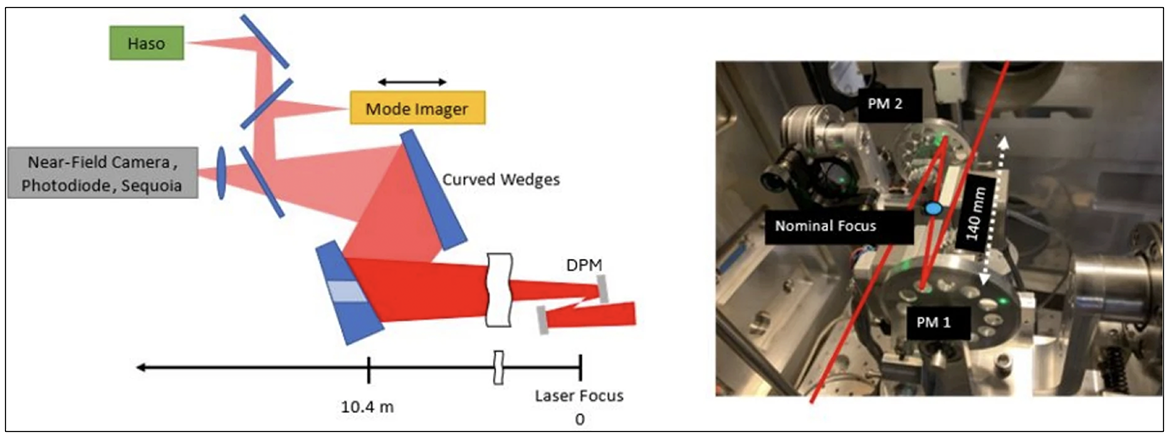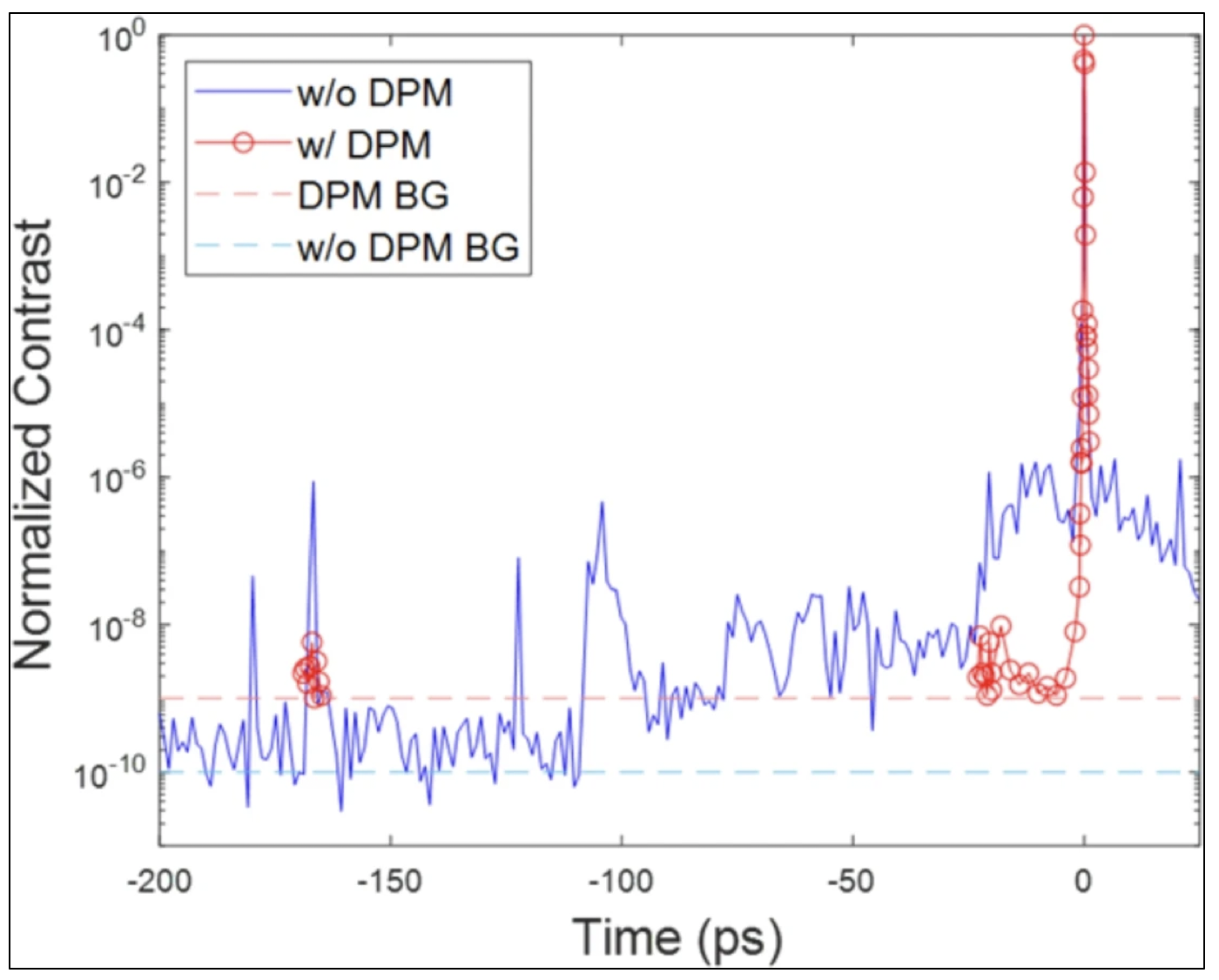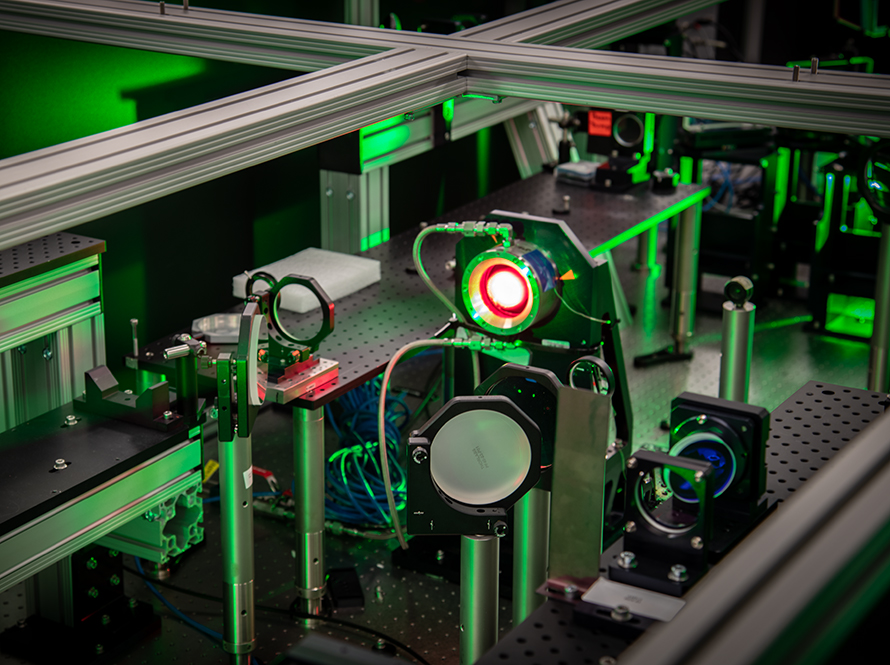Scientific Achievement
Controlling the temporal contrast and eliminating unwanted pre-pulses and pulse pedestals are crucial in high-energy-density science (HEDS) experiments, particularly those aimed at efficiently accelerating protons with lasers at ultra-high intensities. In these experiments, the proton-generating target can be significantly degraded by the laser signal that occurs before the main pulse, which can negatively affect the properties of the proton beam.
New research has, for the first time, demonstrated effective temporal contrast cleaning at high laser energy throughput using thin liquid crystal films at petawatt-class laser powers. The work involved researchers from the BELLA Center in the Accelerator Technology & Applied Physics (ATAP) Division at the U.S. Department of Energy’s Lawrence Berkeley National Laboratory (Berkeley Lab) and Ohio State University.
Significance and Impact
HEDS experiments often involve complex targets exposed to ultra-high laser intensities to investigate particle generation, X-rays, and gamma rays in extreme fields, as well as plasma processes in inertial confinement fusion, laboratory astrophysics, and strong-field quantum electrodynamics. Amplification of high-power laser pulses can cause undesirable pre-pulses and pulse pedestals, which can significantly impact the target before the main laser pulse arrives. As experiments consistently strive for higher peak intensities, these temporal contrast features must be efficiently filtered out on ultrafast timescales, ranging from femtoseconds to picoseconds, to maintain target integrity and ensure clear results.

To date, ultra-fast temporal contrast cleaning has been primarily achieved using polished glass substrates that transmit pre-pulses and pulse pedestals until the laser intensity increases sufficiently to turn them into plasma mirrors, fully reflecting the main laser pulse, which is then useful for HEDS experiments downstream. Destroying the plasma mirror region requires moving the substrate to a new position for each laser shot. With shot repetition rates of 1-10 Hz, plasma mirror assemblies need large substrates and long translation stages to reach high shot counts before substrate replacement becomes necessary.
This work presents the use of ultra-thin liquid crystal films as plasma mirrors, a technique pioneered at The Ohio State University, which are replenished after each laser shot with a compact, motorized film formation system. Very little liquid crystal is needed to wipe thousands of films, making this a cost-effective solution for maintaining plasma mirror operation. For the first time, a detailed study of temporal contrast enhancement, optical quality, and reflection efficiency was conducted at pulse energies of 7 and 20 J using the BELLA Petawatt (PW) laser.
Research Details
The researchers used two liquid crystal film formation devices, each made of spinning disks with circular openings that sweep over stationary tissue wipers saturated with liquid crystal. Films, 20-40 nanometers thick, formed within the openings and were then used as double plasma mirrors to reflect petawatt-class laser pulses. Films were produced at a rate that allowed for several laser shots per minute, a speed that can be increased to 1 Hz to support continuous, high-repetition-rate operation of plasma mirrors with petawatt-class lasers.
The BELLA PW laser was operated at a pulse energy of 7 J on the plasma mirrors, with some datasets also collected at 20 J. The quality of the reflected laser mode was evaluated for the first time by measuring the wavefront using a Shack-Hartmann sensor and analyzing the focused beam on a focal spot camera, then comparing it to the mode properties when bypassing the double plasma mirror. No significant difference was observed between the two cases, indicating that the mode quality was well preserved upon reflection.

The temporal profiles of the DPM reflected(red) and Reference (blue) pulses. The circles represent an average taken of shots that were above the background threshold.
The efficiency of temporal contrast cleaning was evaluated using a scanning third-order cross-correlator, and a contrast enhancement of two to three orders of magnitude was observed for the reflected laser pulses. This improvement closely matched theoretical calculations and could be further optimized by more precise adjustments to the film thickness. Finally, the team demonstrated a total laser energy throughput of up to 80%, which is exceptionally high for a double plasma mirror system. A model was created to predict energy throughput, successfully capturing the trends seen in this experiment.
Led by researchers from The Ohio State University, working in collaboration with colleagues from ATAP, the work was conducted on the BELLA PW laser under LaserNetUS, a network of laser systems across North America funded by the DOE’s Office of Fusion Energy Sciences. This network offers access to its facilities through a single access model. The PW and the Hundred Terawatt Thomson laser systems at BELLA are available to users via LaserNetUS.
Contact: Lieselotte Obst-Huebl
Researchers: Lieselotte Obst-Huebl, Jianhui Bin, Anthony J. Gonsalves, Sven Steinke, Kei Nakamura, Carl B. Schroeder, Eric Esarey, Cameron G. R. Geddes (Berkeley Lab), and Nick Czapla, Derek M. Nasir, Anthony Zingale, Douglass W. Schumacher (The Ohio State University).
Funding: This work was supported by the U.S. Department of Energy (DOE) Office of Science Offices of High Energy Physics, Fusion Energy Sciences, and LaserNetUS, and the DOE National Nuclear Security Administration.
Publication: Nick Czapla, Derek M. Nasir, Lieselotte Obst-Huebl, Anthony Zingale, Jianhui Bin, Anthony J. Gonsalves, Sven Steinke, Kei Nakamura, Carl B. Schroeder, Eric Esarey, Cameron G. R. Geddes, and Douglass W. Schumacher. “A renewable double plasma mirror for Petawatt-class lasers,” Sci. Rep. 15, 21115 (2025). https://doi.org/10.1038/s41598-025-07016-3
For more information on ATAP News articles, contact caw@lbl.gov.
